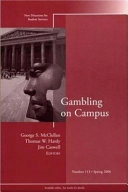Gambling has always been a part of the human experience, and it is arguably now more popular than ever around the world. Fueled by changes in communication, commerce, and cultural values, gambling opportunities are seemingly ubiquitous. It is not surprising-given this societal context, students' perceptions regarding money, and their developmental stages-that many of them are engaged in gambling activity to one degree or another. Evidence suggests, however, that many in higher education remain unaware of the extent of the gambling activity in which students (and members of the staff and faculty for that matter) are engaged, the extent of problem gambling and pathological gambling among students, and the potential consequences of campus gambling for students and institutions. It has been noted that this generation of students grew up in an era when gambling was always commonplace and widely accepted. Given our history, the current popularity of gambling, and the role of gaming in the marketplace, it appears likely that gambling activity will continue to be a part of campus life. This volume of New Directions for Student Services offers information, suggestions for research, frameworks for policy development, and models for practice related to campus gambling. We hope it proves useful to students and faculty in higher education graduate preparation programs, student affairs professionals, other members of the higher education community, and all those interested in supporting student success.
This is the 113th issue of the Jossey-Bass series New Directions for Student Services.
Åtkomstkoder och digitalt tilläggsmaterial garanteras inte med begagnade böcker





















